WD Red Pro 6 TB Review - High Performance NAS HDD Gets a Capacity Bump
by Ganesh T S on September 7, 2015 8:00 AM EST- Posted in
- NAS
- Storage
- HDDs
- Western Digital
RAID-5 Benchmarking - Miscellaneous Aspects
Consumers are rightly worried about RAID rebuilds and the scope for drive failures during that process. As one of our evaluation aspects, we randomly yanked out a disk during operation and cleaned it up for rebuild. We recorded the resync duration (time taken to rebuild a 3-disk RAID-5 volume when one of the disks needs to be replaced) as well as the average power consumption during that process. The two aspects, considered together, give an idea of the efficiency of the hard drive. The graph below presents the total energy consumption (Resync Power Consumption (W) X Resync Duration (s)) for the resync.
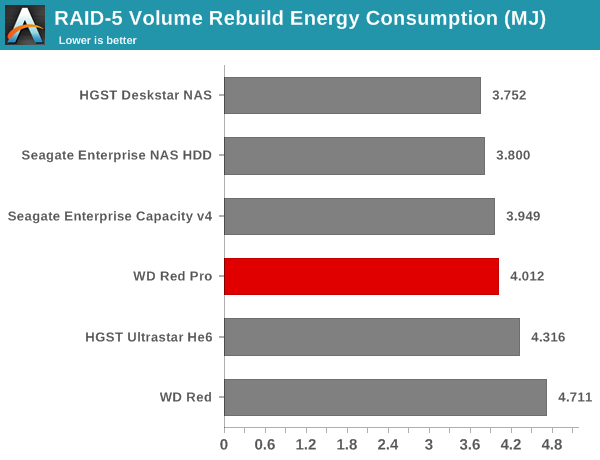
While the energy consumption aspect provides a consolidated view of the various factors, it is still worthwhile to look at the power consumption and resync duration numbers separately. The table below provides the raw information behind the above graph. While the resync duration for the Red Pro is the lowest, the power consumption during the process was also the highest amongst all the evaluated drives. The nett result is that the drive comes in the middle of the pack when it comes to energy efficiency.
| RAID-5 Resync Power Consumption & Duration | ||
| Drive | Power (W) | Duration (s) |
| WD Red Pro | 111.9 | 35850 |
| Seagate Enterprise Capacity v4 | 105.42 | 37462 |
| Seagate Enterprise NAS HDD | 101.91 | 37284 |
| HGST Deskstar NAS | 101.46 | 36981 |
| HGST Ultrastar He6 | 95.36 | 45260 |
| WD Red | 90.48 | 52072 |
We also measured power consumption during the last stage of our multi-client test. With 25 different clients simultaneously stressing the NAS with different types of workloads, we recorded the power consumption at the wall for the NAS as a whole. The various numbers are presented in the graphs below.
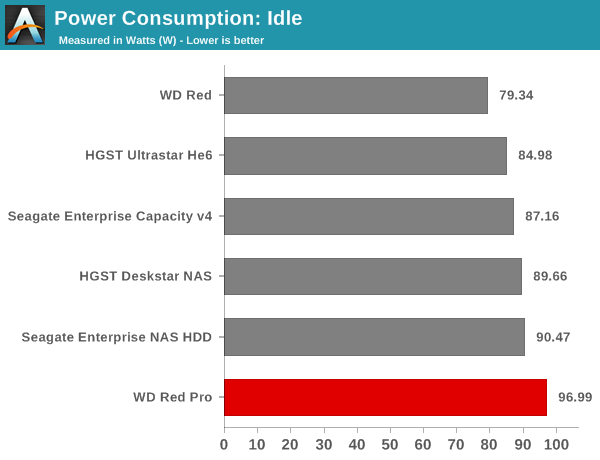
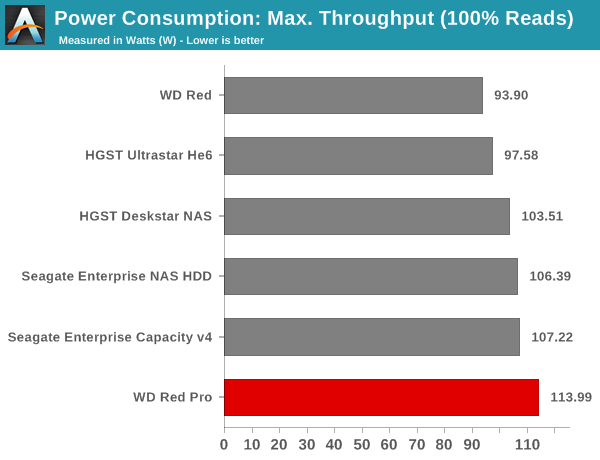
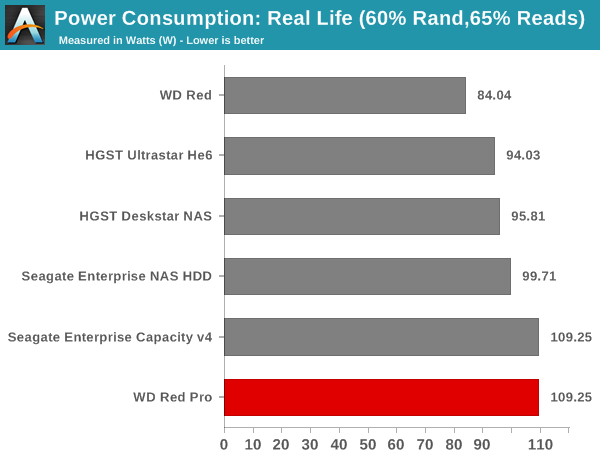
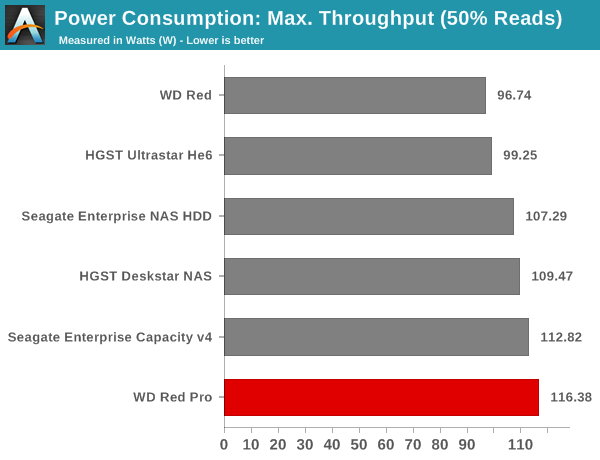
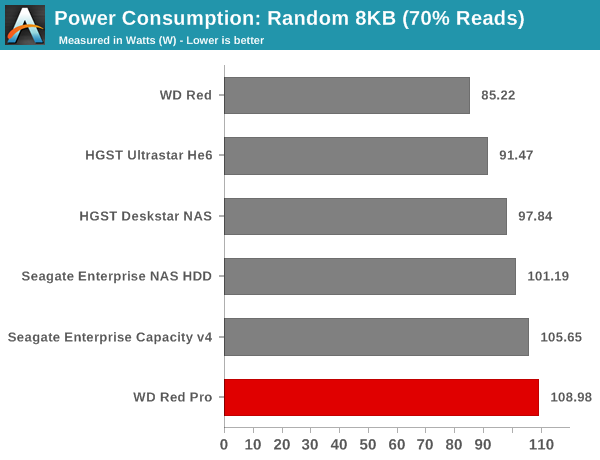
The WD Red Pro is simply not the most power-efficient NAS drive that we have evaluated. Except for the 5400 RPM WD Red, all the other drives that we have in the graphs above are 7200 RPM drives. Despite that fact, the WD Red Pro has the highest average power consumption for all our workloads. However, for a given fixed set of transactions, we expect that the energy efficiency of the WD Red Pro will not be at either extreme (similar to the RAID resync scenario).










62 Comments
View All Comments
Samus - Tuesday, September 8, 2015 - link
At the current rate, it'll be only a few years before NAND hits parity with magnetic storage in capacity and price.3D (verticle) NAND and Intel's 3D X-Point are going to revolutionize storage as we know it.
X-Point will slowly make NAND a cheap commodity for the consumer sector (abandoned by the enterprise sector for X-Point) and NAND will be so cheap to produce by that point (it's 30 year old technology) that it'll be the common medium. It has already killed virtually every other form of portable storage (floppy disks, tapes, CD/DVD/Bluray, etc) with the only worthy exception being large capacity (2-4TB) 2.5" portable hard disks. It's only a matter of time before 4TB SSD's cost nearly the same as 4TB hard disks, and hard disk platter density is already hit some physical barriers, hence the need for shingled recording and other reliability/performance sacrifices.
But even then, soon,
Souka - Monday, September 7, 2015 - link
SSDs aren't for NAS due to pricingIf you put a SSD in, many of the charts would be unreadable due to scaling issues.
Also, if the NAS is used for large number of writes, the SSD reliability would be a factor
melgross - Monday, September 7, 2015 - link
Reliability would not be a factor. Large financial institutions are using them for transaction processing, and few things require more write reliability than that.FunBunny2 - Tuesday, September 8, 2015 - link
The advantage of SSD is, according to legend at least, a more consistent life time: just retire them at x% of warranty, less infant mortality and random death (getting run over by a bus, in human terms).MrSpadge - Monday, September 7, 2015 - link
The strong DAS performance bodes well for the new 6 TB Black model, which is probably physically similar but with different firmware settings.Wwhat - Monday, September 7, 2015 - link
Why is the article listing the WD red pro with the addition 'star NAS'? Since when is WD using the 'star' term? I can't imagine them doing so, and especially see a company market something with 'red star' these days :)A quick web search shows only anadtech adds 'star' the the name.
Morawka - Monday, September 7, 2015 - link
disappointing performance. basically every other nas drive on the market is faster than these. HGST and Seagate dominating.star-affinity - Tuesday, September 8, 2015 - link
According to the benchmarks in this article – as a DAS drive the WD Red Pro seems nice – but it for some reason seems not as good when used as a NAS drive, agreed on that.Arbie - Monday, September 7, 2015 - link
We want eight and we won't wait.Gigaplex - Monday, September 7, 2015 - link
Colour me disappointed that there is no analysis of acoustic behaviour. My NAS is by far the loudest device in my room due to the 4 WD Red (non pro) drives in it, and they're supposed to be one of the quietest drives available.